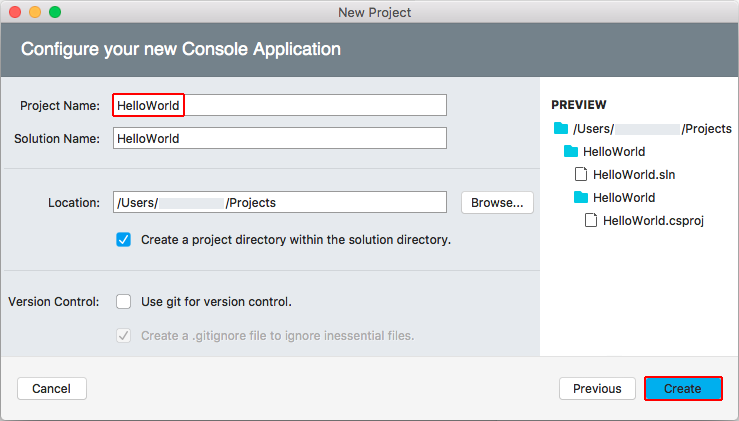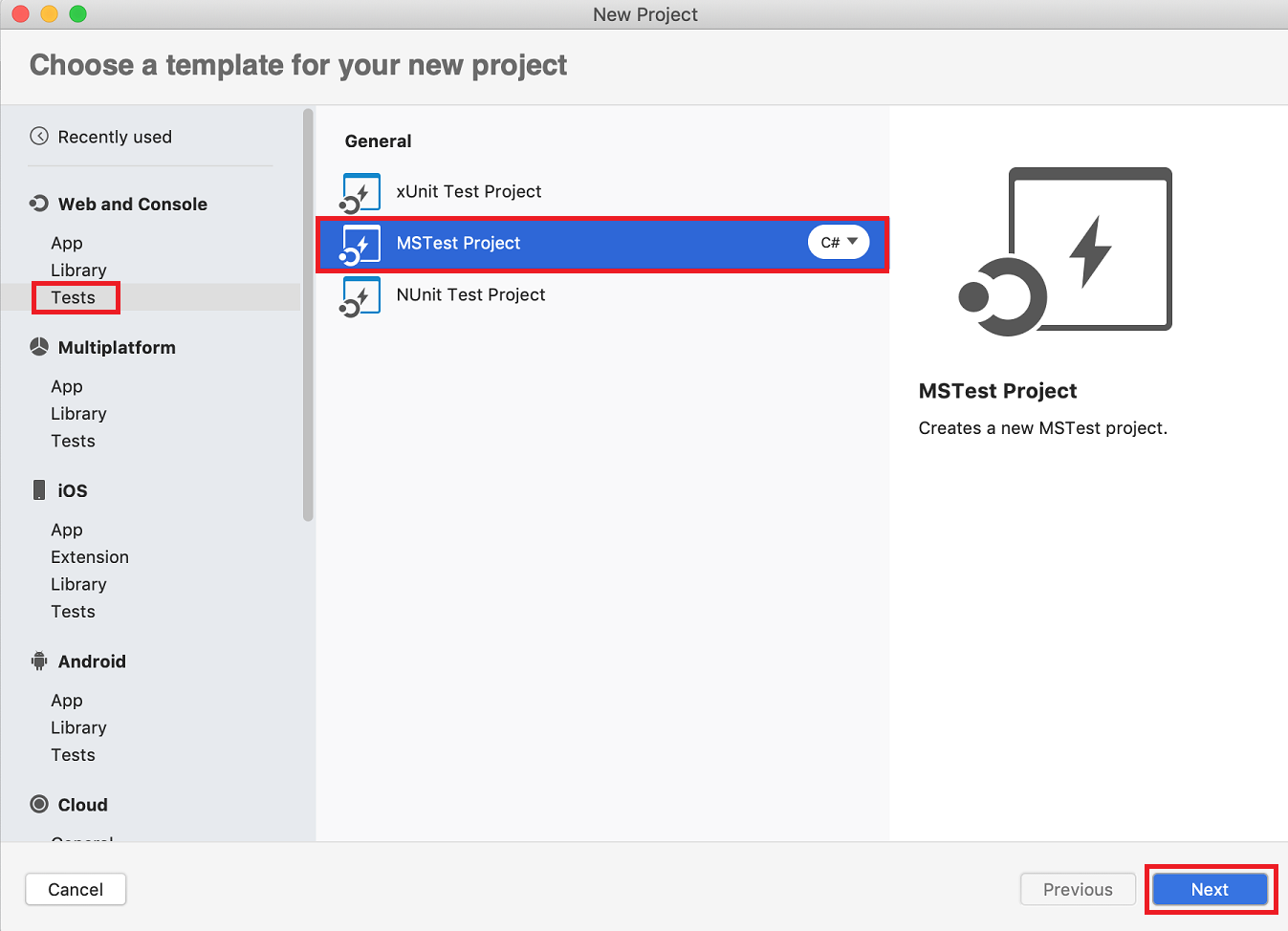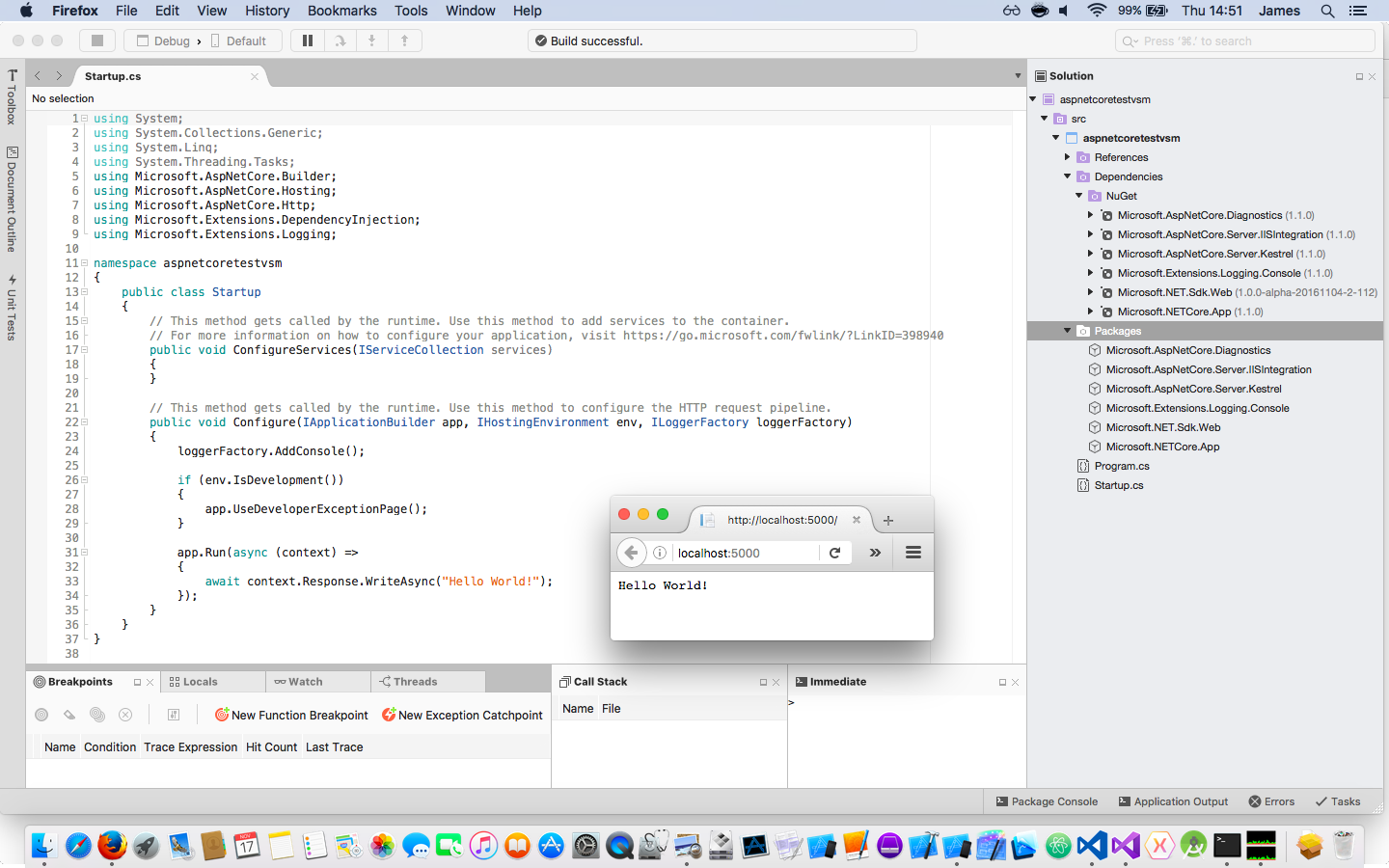- Visual Studio Net 2003 Download
- .net Core Download For Visual Studio Mac Download
- .net Core Visual Studio Mac
- .net Core Download For Visual Studio Mac Os
Visual Studio for Mac enables web and cloud developers on macOS to build applications using.NET Core. This video shows how to get started building web applications in Visual Studio for Mac and how to. Day 9 - Creating a.NET Core Console App inside of Visual Studio Code Day 10 - Using JetBrains Rider with a.NET Core Console Application In this post, we’re going to look at running the app from the command line and then the Mac. To download any other version of.NET Core, visit the dotnet page. When using.NET Core 3.0, C# version 8 will be used by default. C# 7.3 is default when using.NET Core 2.x. See C# language versioning for more info. For information on installing a preview version of Visual Studio for Mac, see the Install a Preview Release guide. Using.NET Core in Visual Studio Code.NET Core provides a fast and modular platform for creating server apps that run on Windows, Linux, and macOS. Use Visual Studio Code with the C# and F# extensions to get a powerful editing experience with C# IntelliSense, F# IntelliSense (smart code completion), and debugging.
-->This tutorial shows how to create and run a .NET Core console application using Visual Studio for Mac.
Note

Your feedback is highly valued. There are two ways you can provide feedback to the development team on Visual Studio for Mac:
- In Visual Studio for Mac, select Help > Report a Problem from the menu or Report a Problem from the Welcome screen, which will open a window for filing a bug report. You can track your feedback in the Developer Community portal.
- To make a suggestion, select Help > Provide a Suggestion from the menu or Provide a Suggestion from the Welcome screen, which will take you to the Visual Studio for Mac Developer Community webpage.
Prerequisites
Visual Studio for Mac version 8.6 or later. Select the option to install .NET Core. Installing Xamarin is optional for .NET Core development. For more information, see the following resources:
- Tutorial: Install Visual Studio for Mac.
- Supported macOS versions.
- .NET Core versions supported by Visual Studio for Mac.
Create the app
Create a .NET Core console app project named 'HelloWorld'.
Start Visual Studio for Mac.
Select New in the start window.
In the New Project dialog, select App under the Web and Console node. Select the Console Application template, and select Next.
In the Target Framework drop-down of the Configure your new Console Application dialog, select .NET Core 3.1, and select Next.
Type 'HelloWorld' for the Project Name, and select Create.
The template creates a simple 'Hello World' application. It calls the Console.WriteLine(String) method to display 'Hello World!' in the terminal window.
The template code defines a class, Program, with a single method, Main, that takes a String array as an argument:
Main is the application entry point, the method that's called automatically by the runtime when it launches the application. Any command-line arguments supplied when the application is launched are available in the args array.
Run the app
Press ⌥⌘↵ (option+command+enter) to run the app without debugging.
Close the Terminal window.
Enhance the app

Enhance the application to prompt the user for their name and display it along with the date and time.
In Program.cs, replace the contents of the
Mainmethod, which is the line that callsConsole.WriteLine, with the following code:This code displays a prompt in the console window and waits until the user enters a string followed by the enter key. It stores this string in a variable named
name. It also retrieves the value of the DateTime.Now property, which contains the current local time, and assigns it to a variable nameddate. And it displays these values in the console window. Finally, it displays a prompt in the console window and calls the Console.ReadKey(Boolean) method to wait for user input.The
nrepresents a newline character.The dollar sign (
$) in front of a string lets you put expressions such as variable names in curly braces in the string. The expression value is inserted into the string in place of the expression. This syntax is referred to as interpolated strings.Press ⌥⌘↵ (option+command+enter) to run the app.
Respond to the prompt by entering a name and pressing enter.
Close the terminal.
Next steps
In this tutorial, you created a .NET Core console application. In the next tutorial, you debug the app.
Visual Studio Net 2003 Download

Changes
- Support NuGet package fallback folders
- Support AssetTargetFallback
- Xamarin.Forms 2.4 support (VS for Mac 7.2.2)
- Fixed transitive types from references not being available
More information on all the new features and changes in Visual Studio for Mac 7.2 can be found in the release notes.
NuGet package fallback folders support
The .NET Core SDK 2.0 defines a NuGet package fallback folder /usr/local/share/dotnet/sdk/NuGetFallbackFolder that can be used when lookingfor NuGet packages whilst restoring. This fallback folder is now supported byVisual Studio for Mac 7.2 so that on restoring a .NET Core 2.0 project the NuGetpackages from the fallback folder will be found and do not need to be downloaded from nuget.org into thelocal machine NuGet package cache ~/.nuget/packages. This should speed up NuGet package restore for .NET Core 2.0 and .NET Standard 2.0 projects the first time it occurs.
As well as the NuGet fallback folders Visual Studio for Mac will now add the following items to the generated project.assets.jsonif they are available:
- configFilePaths
- sources
- warningProperties
AssetTargetFallback support
The .NET Core 2.0 SDK uses an AssetTargetFallback MSBuild propertydefined in an imported SDK MSBuild files. This is used insteadof the PackageTargetFallback property when determining if a NuGetpackage is compatible. Currently the AssetTargetFallback propertyis set to net461 by the .NET Core 2.0 SDK which allows .NET Core projects to use NuGetpackages that include assemblies that target the full .NET Framework.The supported fallback frameworks are now added to the generatedproject.assets.json file by Visual Studio for Mac when a .NET Core 2.0 project is restored.
NuGet package restore now fails if package and asset target fallbacks are defined by a project
If both AssetTargetFallback and PackageTargetFallback are defined by a project then theNuGet restore will fail with an error indicating that they cannotbe used together. This mirrors the behaviour of the .NET Core commandline restore.
Mark implicit PackageReferences as auto referenced
PackageReference items that have IsImplicitlyDefined set to truein their metadata now have autoRefererenced set to true in the project.assets.json file.
.net Core Download For Visual Studio Mac Download
Support parsing MSBuild conditions with unquoted properties
The .NET Core 2.0 SDK uses conditions that pass properties to theExists function without using single quotes around the MSBuild property.This is now supported by Visual Studio for Mac.
Xamarin.Forms 2.4 support
The following sections cover bug fixes made in Visual Studio for Mac 7.2.2to improve support for Xamarin.Forms 2.4 and later versions. Xamarin.Forms 2.4 includes .NET Standard support as well as defining default MSBuild items for.NET Core and .NET Standard projects. These default MSBuild items were nothandled by Visual Studio for Mac 7.2.0 and earlier versions. The main symptoms of Visual Studio for Mac not supporting Xamarin.Forms 2.4 were:
- Duplicate .xaml files in the Solution window.
- Nesting of .xaml and .xaml.cs files not working in Solution window.
- MSBuild items incorrectly added to SDK style projects.
Generated NuGet files being imported twice

The generated NuGet files, .nuget.g.targets and .nuget.g.props,that are created for .NET Core projects were being imported twice.Once by Microsoft.Common.props, that is provided with Mono, and onceby Visual Studio for Mac.
This double import was causing a duplicate fileto be added to theproject when Xamarin.Forms 2.4was used in a .NET Standard project and the .NET Core SDK was notinstalled. This would result in the .xaml file and associated.xaml.cs file not being nested in the solution window.
.net Core Visual Studio Mac
MSBuild items added when new xaml file added to project
Adding a new Xamarin.Forms content page with XAML would incorrectly add anupdate item to the project for the .xaml.cs file when an SDK style projectwas used.
When a new .xaml file was added to an SDK style project a None item as well as an EmbeddedResource item would incorrectly be added to the project file.
Compile item added with DependentUpon metadata
Xamarin.Forms 2.4 defines a wildcard update similar to:
When a project was saved in Visual Studio for Mac a Compile item wasincorrectly added to the main project with the evaluated value stored in theDependentUpon element.

DependentUpon being evaluated incorrectly
Metadata defined for wildcard MSBuild items were being evaluated usingthe wildcard item instead of the expanded item. Thiswas causing .xaml.cs files to not be nested in the Solution windowfor Xamarin.Forms 2.4.
Xamarin.Forms 2.4 defines an update item similar to:
The DependentUpon property was evaluated using the wildcard itemwhich resulted in the DependentUpon property beingevaluated as ‘*.xaml.cs’ instead of the filename of the item that wasupdated by the wildcard.
Define MSBuildSDKsPath for MSBuild engine host
MSBuild when run on the command line defines the MSBuildSDKsPath inits MSBuild.dll.config file. The MSBuild engine host that is usedwhen building with Visual Studio for Mac now also defines the MSBuildSDKsPath property. Previously this was not being defined.
This fixes a build error when using Xamarin.Forms 2.4.0 in an SDK styleproject that targets .NET Standard. Xamarin.Forms 2.4.0 uses defaultitem imports which were not being included since they are conditionallyimported based on the MSBuildSDKsPath property value:
If the SDK style project had a .xaml file and a .xaml.cs file thenthe .xaml.g.cs file was not being generated when the project had no filesexplicitly defined in the project file. Thisthen caused a build error about the InitializeComponent method notbeing defined.
.net Core Download For Visual Studio Mac Os
Bug Fixes
Fixed transitive assembly references not available until restart
Given a solution that contains three .NET Standard projects: LibCreferences LibB which references LibA. If the Newtonsoft.Json NuGetpackage was installed into LibA the types from this NuGet packagewere not available in LibB or LibC until the solution was closed andre-opened again. Closing and re-opening the solution refreshes thereference information used by the type system. Now when a NuGetpackage is installed into a .NET Core project the projects thatreference this project have their reference information refreshed. Types fromthe installed NuGet packages are then available in projects thatreference this updated project either directly or indirectly.
Fixed transitive project references after editing a project file
Given a solution that contains three .NET Standard projects: LibC referencesLibB which references LibA. If a NuGet package is added to LibA byediting its project file in the text editor the types from this NuGetpackage were not available to LibB or LibC without restarting Visual Studiofor Mac or until the packages were restored for the solution. Now when the project fileis saved the projects that directly or indirectly reference the projectwill be restored.
Ignore project references with ReferenceOutputAssembly set to false when restoring
Project references that have ReferenceOutputAssembly are now notadded to the project.assets.json file. This was causingthe NuGet package restore to fail in some cases. For example, if a .NET Standardproject has a project reference to a .NET Core App project, but has theReferenceOutputAssembly set to false, then running dotnet restore from thecommand line would work, but the restore would fail in Visual Studio for Mac.
